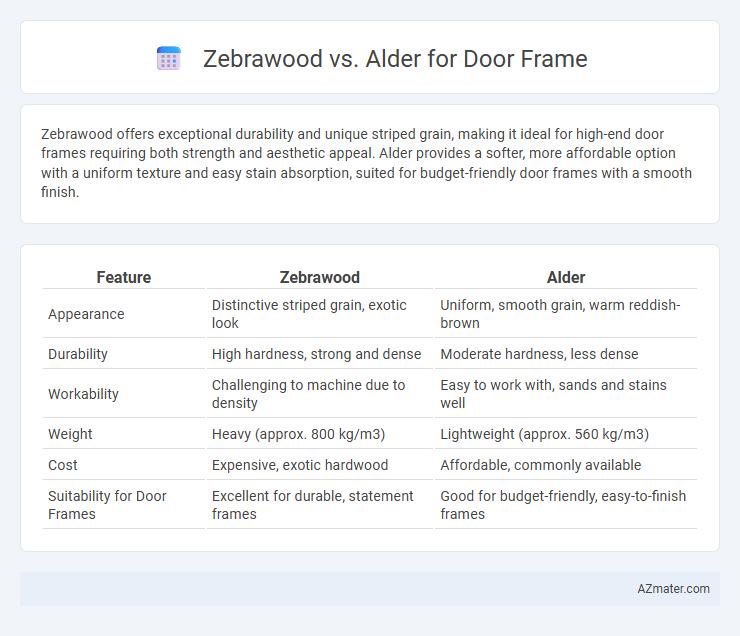Zebrawood offers exceptional durability and unique striped grain, making it ideal for high-end door frames requiring both strength and aesthetic appeal. Alder provides a softer, more affordable option with a uniform texture and easy stain absorption, suited for budget-friendly door frames with a smooth finish.
Table of Comparison
| Feature | Zebrawood | Alder |
|---|---|---|
| Appearance | Distinctive striped grain, exotic look | Uniform, smooth grain, warm reddish-brown |
| Durability | High hardness, strong and dense | Moderate hardness, less dense |
| Workability | Challenging to machine due to density | Easy to work with, sands and stains well |
| Weight | Heavy (approx. 800 kg/m3) | Lightweight (approx. 560 kg/m3) |
| Cost | Expensive, exotic hardwood | Affordable, commonly available |
| Suitability for Door Frames | Excellent for durable, statement frames | Good for budget-friendly, easy-to-finish frames |
Introduction to Zebrawood and Alder
Zebrawood, known for its distinctive striped grain and high density, offers exceptional durability and a striking aesthetic, making it a premium choice for door frames requiring both strength and visual appeal. Alder is a softer hardwood with a fine, uniform texture and warm, reddish-brown hues that provide an affordable, easily workable option suitable for painted or stained door frames. Both woods present unique characteristics influencing their suitability for various interior design preferences and functional requirements.
Origin and Availability
Zebrawood, native to West Africa, is prized for its distinctive dark stripes and limited availability, making it a premium choice for door frames. Alder, commonly found in North America and Europe, offers widespread accessibility and affordability due to its abundant supply. The contrast in origin and market presence influences the cost and selection between these two woods for door frame construction.
Appearance and Grain Patterns
Zebrawood features a striking, bold grain pattern with dark brown to black streaks contrasting against a light brown or golden background, creating a dramatic and exotic appearance. Alder, in comparison, has a more uniform, fine, and straight grain with subtle variations, offering a smooth and warm reddish-brown hue. The unique, high-contrast stripes of Zebrawood make it ideal for statement door frames, while Alder provides a classic, understated elegance suited for traditional or rustic interior designs.
Durability and Strength
Zebrawood offers exceptional durability and high-density strength, making it ideal for door frames that require resistance to wear and impact. Alder, while softer and less dense than Zebrawood, provides moderate strength and greater flexibility, which can be beneficial for door frames in less demanding environments. Choosing Zebrawood ensures enhanced structural integrity and longevity, whereas Alder is better suited for cost-effective applications with lighter usage.
Workability and Ease of Installation
Zebrawood offers a striking striped grain but is notably harder and denser, making it more challenging to cut and shape for door frames compared to Alder. Alder is a softer hardwood with excellent workability, allowing for smoother cutting, nailing, and routing, which simplifies the installation process. Due to its fine grain and uniform texture, Alder ensures easier handling and faster fitting, especially beneficial for custom door frame projects.
Cost Comparison
Zebrawood door frames typically cost significantly more than alder due to their exotic nature and limited availability, with prices often ranging from $15 to $25 per board foot compared to alder's more affordable $5 to $8 per board foot. The high cost of zebrawood is driven by its unique striped grain pattern and durability, making it a premium choice for custom or high-end door frames. Alder offers a cost-effective alternative with sufficient strength and a smooth finish, making it ideal for budget-conscious projects without sacrificing quality.
Environmental Impact
Zebrawood, sourced from Africa, is often harvested unsustainably, leading to deforestation and habitat loss, which raises significant environmental concerns. Alder, mainly grown in North America, is typically available from managed forests and offers a more renewable option due to faster growth rates and responsible forestry practices. Choosing alder for door frames results in a lower carbon footprint and supports sustainable timber production compared to the environmental strain associated with Zebrawood.
Maintenance and Longevity
Zebrawood offers exceptional durability and resistance to wear, requiring minimal maintenance which involves occasional cleaning and refinishing to preserve its unique striped look. Alder, while softer and easier to work with, demands more frequent upkeep, including regular sealing and protection against moisture to prevent dents and scratches. The longevity of Zebrawood in door frames outperforms Alder due to its dense grain structure, making it a better investment for high-traffic or exterior applications.
Best Applications for Each Wood
Zebrawood offers high durability and striking striped aesthetics, making it ideal for decorative door frames in luxury homes and modern interior designs where visual impact is essential. Alder is softer and easier to work with, providing a smooth finish perfect for painted or stained door frames in traditional or cost-effective residential projects. Choosing Zebrawood enhances strength and exotic appeal, while Alder ensures affordability and versatility in various architectural styles.
Final Verdict: Choosing the Right Wood for Your Door Frame
Zebrawood offers exceptional durability and a striking striped grain, making it ideal for door frames that require both strength and aesthetic appeal, especially in high-traffic areas. Alder, with its smooth texture and warm tone, provides an affordable, easy-to-work option suitable for interior door frames where moderate durability is sufficient. For exterior door frames or high-impact zones, Zebrawood is the premium choice, while Alder excels in budget-conscious projects requiring a clean, classic finish.

Infographic: Zebrawood vs Alder for Door Frame
 azmater.com
azmater.com